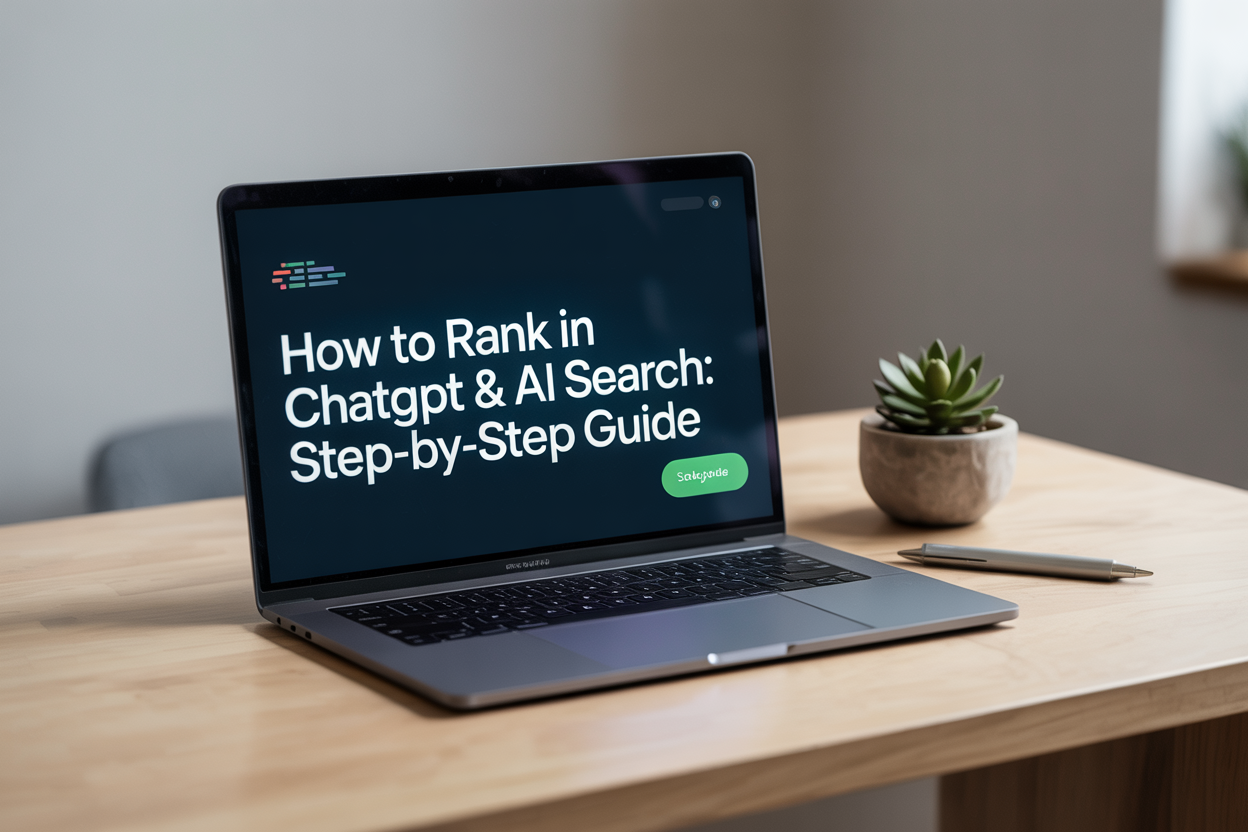
How to Rank in ChatGPT & AI Search: Step-by-Step Guide
Goal: Learn how to rank in ChatGPT and AI search by making pages that AI can quote. Old SEO chased clicks. Today, AI search rewards pages with clear facts, short steps, and simple definitions.
1) Why Ranking in AI Search Matters Now
- AI gives direct answers, so fewer users click through to websites.
- Organic links sit below ads, AI boxes, and big-brand results.
- AI leans on sources it trusts and can easily cite.
Bottom line: Be the source AI wants to cite.
2) SEO vs AEO vs “Rank in AI” (GEO)
| Method | Main Goal | Where It Shows | How You Win |
|---|---|---|---|
| SEO | Clicks from search results | Google/Bing organic listings | Rank for keywords; earn clicks |
| AEO | Selected answers/snippets | Featured snippet, voice search | Answer direct questions clearly |
| “Rank in AI” (GEO) | Be cited inside AI answers | ChatGPT, Perplexity, Claude, Google AI Overview | Provide citable facts, steps, and definitions |
3) Step 1 – Shift Your Goal: From Clicks to Citations
- Write short, verifiable statements that stand on their own.
- Ask: “Would AI quote this line as the answer?”
- Pick a narrow topic cluster so AI can “see” your specialty faster.
Example cluster: “How to rank in ChatGPT & AI search” (hub) + subtopics (schema, LLMs.txt, internal links, testing, tools, action plan).
4) Step 2 – Structure Content for Machines (and Humans)
- Paragraphs: 2–3 short sentences.
- Headings: H2 for big ideas, H3 for sub-steps.
- Lists: Bullets for features; numbers for steps.
- Tables: For comparisons, stats, settings.
- One bold takeaway sentence per section.
WordPress tip: Use Gutenberg blocks (Heading, List, Table). For advanced tables, install TablePress.
5) Step 3 – Add Schema (FAQ, HowTo, Article) in WordPress
Schema labels your content for machines. You want AI to “see” what each part is.
- Article — every post.
- FAQPage — your Q&A section.
- HowTo — step-by-step guides.
How (Rank Math)
- Edit post → Rank Math → Schema → Schema Generator.
- Select Article + FAQ or HowTo as needed.
- Fill all fields (questions/answers; steps/tools/time; author/date).
- Validate with Google’s Rich Results Test.
Trust rule (Josh-style): Match intent, use plain language, and when you quote data, link a non-competing high-authority source.
6) Step 4 – Create LLMs.txt (Robots for AI Crawlers)
LLMs.txt is like robots.txt but aimed at AI crawlers (Large Language Models). You “hint” which pages are your best sources.
Simple LLMs.txt Example
User-agent: GPTBot Allow: /blog/rank-in-ai-search/ Allow: /blog/ai-search-faq-schema/ Disallow: /private/ Sitemap: https://example.com/sitemap.xml User-agent: ClaudeBot Allow: /blog/ Disallow: /private/ User-agent: PerplexityBot Allow: /
How to Add It
- Create a text file named
llms.txt. - Paste the rules above (edit your paths).
- Upload to your site’s root (same folder as
robots.txt). - Open
https://yourdomain.com/llms.txtto confirm it loads.
List only your most citable pages: guides with steps, tables, definitions, and fresh stats.
7) Step 5 – Build Entity & Topical Authority with Internal Links
Make a simple hub-and-spoke and link both ways with natural anchor text.
- Hub page (master guide) links to each spoke (support article).
- Each spoke links back to the hub.
- Spokes cross-link when it helps the reader.
Tool: Link Whisper suggests internal links automatically inside WordPress.
8) Step 6 – Write Citation-Friendly Blocks
AI loves content it can quote cleanly.
- Short definitions: 1–2 sentences.
- Numbered steps: 5–9 steps with action verbs.
- Stats with dates: keep them current.
- Tables: clean data AI can scan.
Before vs After
Before: “We help businesses get more leads.”
After: “In our 2024 survey, 78% of new customers reported 30%+ more leads within 90 days.”
Editing tools: Hemingway or Grammarly for short, clear sentences.
9) Step 7 – Test in AI Platforms and Improve
- Perplexity: ask “How do I rank in ChatGPT and AI search?” Check sources. Are you cited?
- ChatGPT (with browsing): ask similar queries; look for your pages.
- Claude: repeat and compare mentions and summaries.
- Update your page to match the formats AIs favor (definitions, steps, tables, stats).
Do this monthly: models shift. Keep tuning.
10) Step 8 – Earn Authority Signals AI Recognizes
- Answer real questions on Quora or niche forums; link your guide when helpful.
- Guest post on a niche blog with a byline link to your hub page.
- Offer expert quotes to journalists (HARO-style boards).
- List your brand in quality niche directories (skip spammy lists).
Tip: One strong mention beats ten weak ones.
11) Step 9 – Keep Pages Fresh
- Refresh key pages every 60–90 days.
- Update stats, screenshots, and examples.
- Show a “Last updated” line near the top.
- Re-test in AI tools after each update.
12) Step 10 – Track Results (Beyond Clicks)
- Manual AI checks: Are you cited this month in Perplexity or ChatGPT?
- Engagement: Time on page; scroll depth on the hub guide.
- Search Console: Are queries rising for your cluster?
- Mentions alerts: Watch your brand and guide titles.
13) Best WordPress Tools for AI Ranking
| Task | Tool | Why |
|---|---|---|
| Schema | Rank Math Pro | Article, FAQ, HowTo; on-page checks |
| Tables | TablePress | Clean, mobile-friendly data tables |
| Internal linking | Link Whisper | Fast, relevant internal links |
| Topic research | Ahrefs / Semrush | Find gaps, related queries, entity ideas |
| Readability | Hemingway / Grammarly | Short, clear sentences |
| Schema testing | Rich Results Test | Validate markup before publishing |
14) Common Mistakes (Easy to Avoid)
- Walls of text. Use headings, lists, and tables.
- No schema. Machines need labels.
- Topic too broad. Start narrow; win the cluster first.
- No testing. Ask the AIs monthly and adjust.
- Bulk links only. A few trusted mentions work better.
15) 30-Day Action Plan
Week 1: Plan
- Pick one cluster + primary keyword (place it in H1, one H2, first 100 words, one image ALT).
- Outline your hub + 4–6 spokes.
- Set short, clean URLs.
Week 2: Build
- Write the hub: definitions, steps, one data table, and an FAQ.
- Add Article + FAQ or HowTo schema (Rank Math).
- Create and upload
LLMs.txt.
Week 3: Link & Share
- Publish 2–3 spokes; link hub ↔ spokes.
- Answer a few real questions on Quora/Reddit and reference your guide.
Week 4: Test & Tune
- Test in Perplexity, ChatGPT, and Claude.
- Adjust formats (steps, stats, tables) based on what AIs cite.
- Set 60-day refresh reminders.
16) FAQ: How to Rank in ChatGPT & AI Search
Do I still need backlinks?
Yes, but focus on trusted sites and real mentions. One strong citation can beat ten weak links.
How long to get cited?
Some niches move in weeks. Most take a couple of months. Keep building and testing.
Can I draft with AI?
Yes—then edit. Keep sentences short. Add real data, steps, and a table.
What is LLMs.txt again?
A simple text file in your site’s root that “hints” AI crawlers toward your best pages.
Which schema should I start with?
Article for the post, then FAQ or HowTo as needed. Fill all fields you reasonably can.
How often should I update?
Refresh key pages every 60–90 days. Update stats and examples, then test again.
17) Wrap-Up & Next Step
Create one hub guide now. Add clear steps, one data table, and an FAQ. Add schema. Upload LLMs.txt. Link two support posts to it. Test in Perplexity and ChatGPT next week. Keep going until you’re cited.
Helpful tool: Validate schema with Google’s Rich Results Test.



